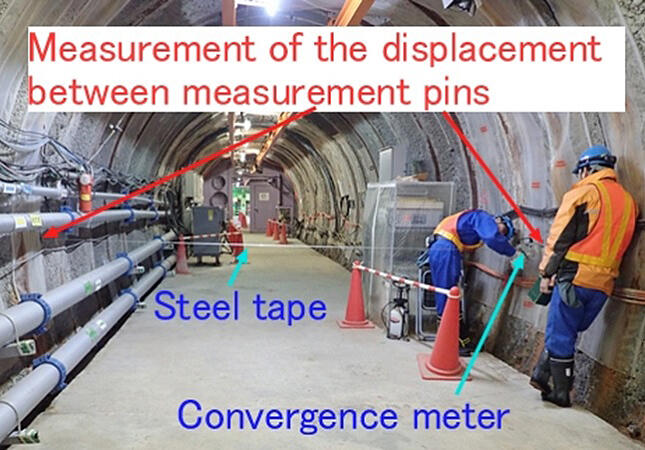Final disposal sites for high-level radioactive waste are envisioned to be a complex structure comprising multiple vertical and horizontal shafts, similar to an ant's nest. The design and post-closure safety assessments of disposal sites require an evaluation of forces (ground pressure) exerted on the rock mass over a wide area around the disposal site. A research group made up of Assistant Principal Researcher Kazuhei Aoyagi of the Horonobe Underground Research Center of the Japan Atomic Energy Agency (JAEA), Team Leader Kentaro Sugawara of the Geoscience Research Laboratory, Advisor Katsumi Kamemura of the Fukada Geological Institute, and General Manager Makito Nago of Taisei Corporation has developed a method for estimating the type of ground pressure acting on a wide area of the rock mass around the tunnel by focusing on the elastic deformation of the rock mass that occurs immediately after tunnel excavation. This study was published in the International Journal of Rock Mechanics and Mining Sciences.

Provided by JAEA
The problem with conventional ground pressure measurement methods was that they could only evaluate ground pressure in areas ranging from several meters to several tens of meters. Therefore, research has been conducted on realizing a method for analytically estimating ground pressure acting on a wide area of rock mass by measuring the deformation of a tunnel compressed by ground pressure, rather than relying solely on direct measurement of ground pressure. However, validating the method has been challenging due to the large variation in the values measured after excavation when the rock mass deformation has stabilized.
To resolve this disparity in tunnel deformation, the research group extracted only those measurements that indicate elastic deformation immediately after excavation from the results of deformation measurements (internal displacement measurements) taken in many tunnels excavated during the construction of the underground facilities at the Horonobe Underground Research Center. The disparity was smaller in the extracted measurements. Based on the results of this analysis, the research group analytically determined the state of ground pressure acting on a wide area of rock mass around the tunnel based on elastic deformation immediately after excavation. It was found that the magnitude and direction of the estimated ground pressure were consistent with the results of existing measurements conducted over a narrow range.
Aoyagi said, "We struggled to faithfully reproduce the excavation in the simulation. Even assuming that the tunnel was dug one meter at a time, a discrepancy of several tens of centimeters would occur, which would greatly affect the measurement results. However, by inputting data measured at the actual site matching the detailed site progress and complex tunnel shapes, we succeeded in reproducing the data."
The proposed method utilizes the internal displacement measurement technique, which is commonly used in tunnel excavation, and is applied on the prerequisite that the tunnel in sedimentary rock undergoes elastic deformation immediately after excavation. This makes it applicable to underground space development projects targeting sedimentary rock. Additionally, by applying this method to a geological disposal project, it is possible to evaluate the magnitude of the ground pressure acting around the disposal site. This method is expected to afford information required for assessing the stress state of rock mass, which relates to the soundness of artificial barriers, based on which their installation site is determined. This method is also expected to provide the information needed for designing backfill for tunnels and for evaluating the migration behavior of radioactive nuclides after the site is backfilled. Moreover, it is expected that the proposed method will be useful for maintenance management, such as confirming the soundness of tunnels after excavation in general civil engineering projects, and evaluating the impact on the surrounding environment, such as assessing ground subsidence after excavation.
Journal Information
Publication: International Journal of Rock Mechanics and Mining Sciences
Title: Estimation of stress state using measured tunnel convergence in loop galleries excavated in mudstone
DOI: 10.1016/j.ijrmms.2024.105776
This article has been translated by JST with permission from The Science News Ltd. (https://sci-news.co.jp/). Unauthorized reproduction of the article and photographs is prohibited.




